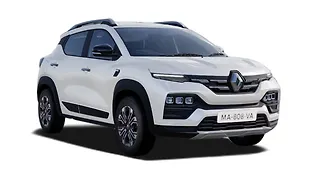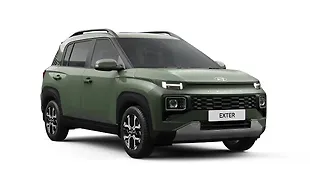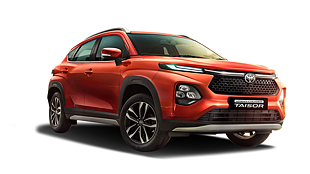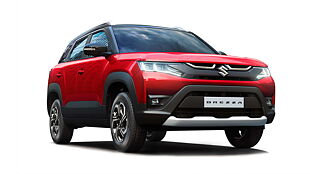Renault Kiger [2021-2022] RXZ Turbo CVT
|Rate & Win
- Kiger [2021-2022]
- Specs & Features
- Variants
- Colours
- User Reviews
discontinued
Variant
RXZ Turbo CVT
City
Show price in my city
Rs. 10.00 Lakh
Last Recorded PriceRenault Kiger [2021-2022] RXZ Turbo CVT Review
Renault-Nissan's alliance brought in two more contenders at a very competitive price in the crowded space of compact SUVs. One being the Nissan Magnite and the other Renault Kiger — the one on which we will focus on here. Now, despite being priced lower amongst its rivals, it's packed with a lot of equipment and is available in a choice of petrol engines and different transmission options. All adding to the mix of varied options for buyers in the heated battle of compact SUVs. Here's what a Kiger buyer can expect as we give you an in-depth idea about its on-road performance.
Introduction
Design and style
Interior
Safety and equipment
Engine and Performance
Ride and Handling
Price and Fuel Economy
Specification
Test Data
Specifications & Features
- Specifications
- Features
- Specifications
- Features
Specifications
Engine & Transmission
Acceleration (0-100 kmph)10.72 secondsEngine999 cc, 3 Cylinders Inline, 4 Valves/Cylinder, DOHCEngine Type1.0L TurboFuel TypePetrolMax Power (bhp@rpm)99 bhp @ 5000 rpmMax Torque (Nm@rpm)152 Nm @ 2200 rpmMileage (ARAI)20.53 kmplDrivetrainFWDTransmissionAutomatic (CVT) - CVT Gears, Sport ModeEmission StandardBS 6Turbocharger / SuperchargerTurbochargedValve/Cylinder (Configuration)4, DOHCDimensions & Weight
Length3991 mmWidth1750 mmHeight1605 mmWheelbase2500 mmGround Clearance205 mmCapacity
Suspensions, Brakes, Steering & Tyres
Features
Exterior
Braking & Traction
Safety
Comfort & Convenience
Lighting
Locks & Security
Doors, Windows, Mirrors & Wipers
Entertainment, Information & Communication
Mobile App Features
Storage
Airbags
Seats & Upholstery
Instrumentation
Manufacturer Warranty
Other Kiger [2021-2022] Variants
| Variants | Price | Specifications | |
|---|---|---|---|
Rs. 10.00 Lakh | 5 Person, FWD, 152 Nm, 205 mm, 405 litres, CVT Gears, 1.0L Turbo, No, 40 litres, No, Front & Rear, 10.72 seconds, 4 Star (Global NCAP), 3991 mm, 1750 mm, 1605 mm, 2500 mm, 152 Nm @ 2200 rpm, 99 bhp @ 5000 rpm, Keyless, Yes (Automatic Climate Control), Front & Rear, 1, Reverse Camera, Wireless, Wireless, No, No, No, 4 Airbags (Driver, Front Passenger, Driver Side, Front Passenger Side), Yes, 0, BS 6, 5 Doors, 20.53 kmpl, Petrol, Automatic (CVT), 99 bhp | Get Offers from Dealers |
Similar Cars
Explore Used Renault Kiger
Colors
Caspian Blue
Mahogany Brown
Moonlight Silver
Ice Cool White
View More Colours
Write a detailed review and you can win Amazon voucher worth Rs. 2,000
Reviews
- (13 Ratings) 8 Reviews
4.7/5
- Kiger - Best of Nexon and venueFirst of all, I like to review it because it is the car that my relatives and family like the most, I do have Nexon and venue, But I liked Kiger better than the venue, but Nexon is good than Kiger, but in terms of comfort, the Kiger is best. If you bought it for your family then definitely Kiger is best. Don't buy automatic variants in any brand all are waste, buy only manual versions.Rating parameters(out of 5)5
Exterior
5Comfort
5Performance
5Fuel Economy
5Value For Money
About the ReviewerPurchase UsedDriven forFew thousand kilometersWas this review helpful?00 - Good carI suggest all those people who are buying this car, (yes ). My driving experience also good . Car looking also awesome, performance also awesome. Servicing and maintenance is cheap.Rating parameters(out of 5)5
Exterior
5Comfort
5Performance
5Fuel Economy
5Value For Money
About the ReviewerPurchase NewDriven forFew hundred kilometersWas this review helpful?21 - Missing safety featuresNow a days very important safety options for suv type need hill hold control, tcs are missing in this vehicle. In this price range other vehicles like Magnite, Nexon has these features. Why Renault not consider this. Look wise only this car is a suv. But safety wise need more safety features. Expect those features one of the top models.Rating parameters(out of 5)5
Exterior
5Comfort
5Performance
4Fuel Economy
4Value For Money
About the ReviewerPurchase Not PurchasedDriven forHaven't driven itWas this review helpful?63
- Home
- Renault Cars
- Kiger [2021-2022]
- RXZ Turbo CVT


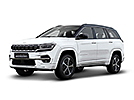

![Renault Kiger [2021-2022] RXZ Turbo CVT Renault Kiger [2021-2022] RXZ Turbo CVT](https://imgd.aeplcdn.com/664x374/n/cw/ec/44407/kiger-exterior-right-front-three-quarter-12.jpeg?q=80)
![Renault Kiger [2021-2022] Right Front Three Quarter Renault Kiger [2021-2022] Right Front Three Quarter](https://imgd.aeplcdn.com/664x374/n/cw/ec/44407/kiger-exterior-right-front-three-quarter-11.jpeg?q=80)
![Renault Kiger [2021-2022] Right Side View Renault Kiger [2021-2022] Right Side View](https://imgd.aeplcdn.com/664x374/n/cw/ec/44407/kiger-exterior-right-side-view-2.jpeg?q=80)
![Renault Kiger [2021-2022] Right Rear Three Quarter Renault Kiger [2021-2022] Right Rear Three Quarter](https://imgd.aeplcdn.com/664x374/n/cw/ec/44407/kiger-exterior-right-rear-three-quarter-2.jpeg?q=80)

![Renault Kiger [2021-2022] Rear View Renault Kiger [2021-2022] Rear View](https://imgd.aeplcdn.com/664x374/n/cw/ec/44407/kiger-exterior-rear-view-2.jpeg?q=80)
![Renault Kiger [2021-2022] Left Rear Three Quarter Renault Kiger [2021-2022] Left Rear Three Quarter](https://imgd.aeplcdn.com/664x374/n/cw/ec/44407/kiger-exterior-left-rear-three-quarter.jpeg?q=80)
![Renault Kiger [2021-2022] Left Side View Renault Kiger [2021-2022] Left Side View](https://imgd.aeplcdn.com/664x374/n/cw/ec/44407/kiger-exterior-left-side-view.jpeg?q=80)

